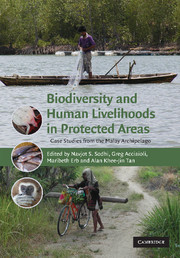Book contents
- Frontmatter
- Contents
- List of contributors
- Acknowledgements
- 1 General introduction
- Part I Conservation needs and priorities
- 2 Introduction to Part I
- 3 Delineating Key Biodiversity Areas as targets for protecting areas
- 4 A Master Plan for Wildlife in Sarawak: preparation, implementation and implications for conservation
- 5 Indonesia's protected areas need more protection: suggestions from island examples
- 6 Birds, local people and protected areas in Sulawesi, Indonesia
- 7 Importance of protected areas for butterfly conservation in a tropical urban landscape
- 8 Biodiversity conservation and indigenous peoples in Indonesia: the Krui people in southern Sumatra as a case study
- 9 Involving resource users in the regulation of access to resources for the protection of ecosystem services provided by protected areas in Indonesia
- 10 Conclusion to Part I
- Part II Conservation with and against people(s)
- Part III Legal and governance frameworks for conservation
- 29 General conclusion
- Index
- References
9 - Involving resource users in the regulation of access to resources for the protection of ecosystem services provided by protected areas in Indonesia
from Part I - Conservation needs and priorities
Published online by Cambridge University Press: 12 November 2009
- Frontmatter
- Contents
- List of contributors
- Acknowledgements
- 1 General introduction
- Part I Conservation needs and priorities
- 2 Introduction to Part I
- 3 Delineating Key Biodiversity Areas as targets for protecting areas
- 4 A Master Plan for Wildlife in Sarawak: preparation, implementation and implications for conservation
- 5 Indonesia's protected areas need more protection: suggestions from island examples
- 6 Birds, local people and protected areas in Sulawesi, Indonesia
- 7 Importance of protected areas for butterfly conservation in a tropical urban landscape
- 8 Biodiversity conservation and indigenous peoples in Indonesia: the Krui people in southern Sumatra as a case study
- 9 Involving resource users in the regulation of access to resources for the protection of ecosystem services provided by protected areas in Indonesia
- 10 Conclusion to Part I
- Part II Conservation with and against people(s)
- Part III Legal and governance frameworks for conservation
- 29 General conclusion
- Index
- References
Summary
Introduction
Natural resources have a limited capacity to sustain use and therefore use needs to be managed (and often restricted) to sustain ecosystem services (e.g. extractive use, tourism, flood control, shoreline protection, etc.). Protected-area management is one management tool that may be applied to manage use. Protected-area management differs from other types of resource-use management, such as catch quota or prohibited fishing gears, in the sense that regulations on use differ between zones within the protected area, and between the protected areas on the one hand and the surrounding area on the other hand.
Deciding on who should have access to resources, and how to regulate access is the core of protected-area management. In this chapter, we show how The Nature Conservancy (TNC), an international organization working in Indonesia, works together with government agencies, NGOs and local communities to manage use in some of the most biodiverse areas on Earth.
As its core approach to conservation, TNC adopted ‘conservation by design’ (The Nature Conservancy 2001), which is in essence a project-management cycle comprising setting priorities, developing strategies, taking action and measuring performance or management impact. The two spatial levels at which this approach is applied are the ecoregion and the site. At the ecoregional level, conservation by design mostly considers spatial patterns in nature at a scale of hundreds to thousands of kilometres to decide where conservation action is needed (Groves et al. 2002).
- Type
- Chapter
- Information
- Biodiversity and Human Livelihoods in Protected AreasCase Studies from the Malay Archipelago, pp. 122 - 138Publisher: Cambridge University PressPrint publication year: 2007
References
- 1
- Cited by

